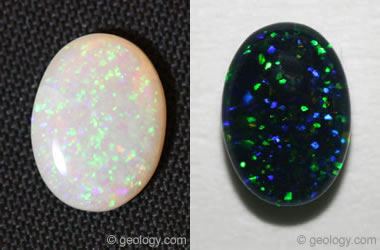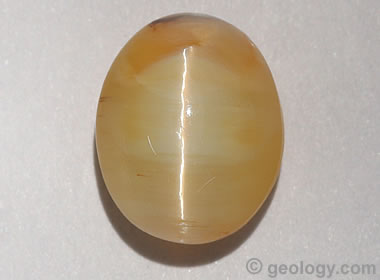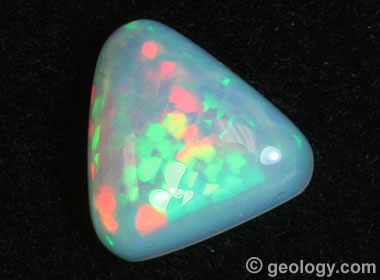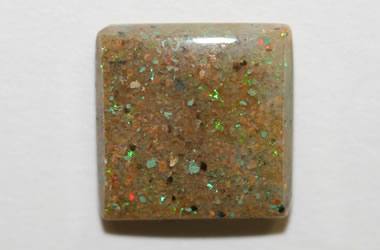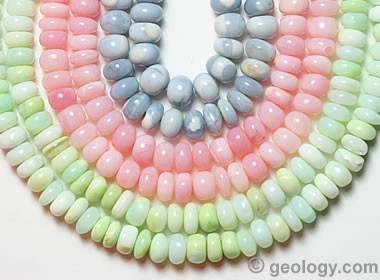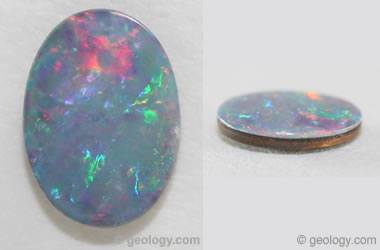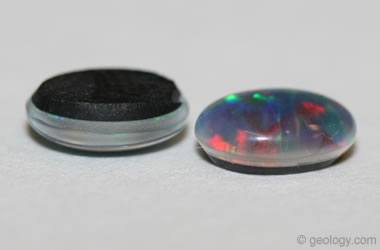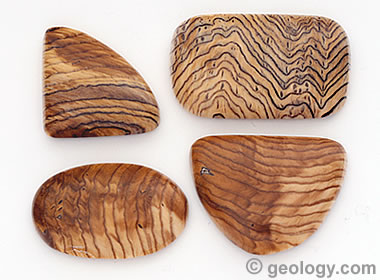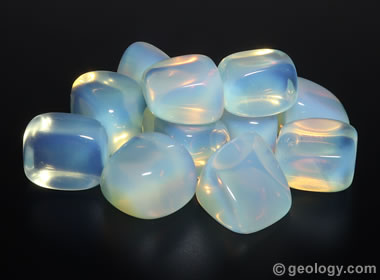Home » Gemstones » Opal Picture Gallery
Pictures of Opal
Precious, Black, Fire, Boulder, Blue, Pink, Common and More
A photographic guide for the names that are used to describe opals.
Author: Hobart M. King, PhD, GIA Graduate Gemologist

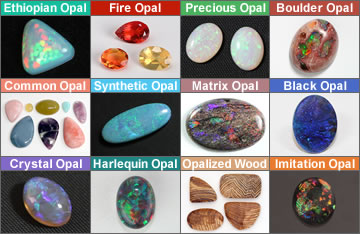
What is Opal? |
VIDEO: The Life of an Opal: Justin at BlackOpalDirect.com shows you the journey of an opal, from mine to workshop to finished gem.
What Is Opal?
Opal is one of the world's most popular gemstones and the birthstone for the month of October. A nice precious opal can flash every color of the spectrum with an intensity and quality of color that surpasses the fire of diamond. The best opals command prices per carat that rival expensive diamonds, rubies, sapphires, and emeralds.
There are many types of opal found in deposits around the world. If you are just starting to learn about opal, here are three varieties that might surprise you: Fire Opal is known for its intense red, orange and yellow colors - the colors of a fire! Boulder Opal is opal with attached host rock. It can be surprisingly beautiful! Common Opal has color, pattern and beauty that can be anything but common. Who gave it such a common name?
Mineralogically, opal is a hydrous silicon dioxide with a chemical composition of SiO2.nH2O. It is amorphous, without a crystalline structure, and without a definite chemical composition (it contains a variable amount of water, as shown by the "n" in its chemical composition). Therefore opal is a "mineraloid" rather than a "mineral."
Opal Can Be Fragile!
Opal is a wonderful stone for earrings, pendants, and brooches. These items of jewelry normally do not receive significant abrasion and impact during wear. Opal is softer and more easily chipped than most other popular gemstones. It has a hardness of about 5.5 to 6.0 on the Mohs hardness scale.
When used in a ring, the best designs have a bezel that fully protects the stone - instead of being placed in a prong setting that exposes the stone to impact and abrasion. Opal rings are beautiful and many people enjoy them. If you decide to wear an opal ring, it is best removed during activities when impact or abrasion might occur.
Physical Properties of Opal |
|
| Chemical Classification | A hydrated variety of amorphous silica |
| Color | Commonly having a bodycolor of white, yellow, gray, black, or brown; however, the bodycolor of opal can be any color. Some of the most beautiful common opals are red, orange, pink, green,or blue. The play-of-color of precious opal displays spectral colors of red, orange, yellow, green, blue, and violet. |
| Streak | White |
| Luster | Rough opal can have a dull, pearly, waxy, or vitreous luster. Most opal polishes to a vitreous luster. |
| Diaphaneity | Translucent, opaque, semi-transparent, and, rarely, transparent. |
| Cleavage | None, breaks with a conchoidal fracture. |
| Mohs Hardness | 5 to 6 |
| Specific Gravity | 2.0 to 2.2, varying with impurities, which include various amounts of water |
| Diagnostic Properties | Conchoidal fracture. Sometimes exhibits play-of-color. Low specific gravity and hardness. |
| Chemical Composition | SiO2.nH2O |
| Crystal System | Amorphous |
| Uses | Commonly used as a gem and as an ornamental stone. |
Physical Properties of Opal
Although opal has a composition that includes SiO2, its physical properties are very different from quartz. Opal also has water, which reduces its specific gravity, gives it a lower hardness, and makes it much more brittle.
Some opal also has an internal structure that consists of regularly packed spheres, which enables it to behave like a diffraction grating and separate light into its component colors - similar to what is done by a prism. This phenomenon is known as "play-of-color". Together, these properties enable it to be a gemstone, albeit a fragile one.
Play-of-Color and Opalescence
Opal is a very common material, found throughout the world. Most opal is "common opal" or opal that lacks the colorful flashes known as "play-of-color". Some people use the name "potch" for this type of opal.
Most common opal has an unremarkable appearance and is almost invariably overlooked in the field. It is often assumed to be quartz or a variety of chalcedony - but a surprising amount of common opal exists.
The rare specimens of opal that exhibit a play-of-color are known as "precious opal". If the play-of-color is of high quality and large enough to cut, the material can be used to produce valuable gemstones.
If you examine a specimen of precious opal under bright light, play-of-color can be observed in three situations: 1) when the stone is moved, 2) when the light source is moved, or, 3) when the angle of observation is changed. The video near the top of this page illustrates the beautiful "play-of-color" in an Ethiopian Welo opal.
The word "opalescence" is often misused. Some people believe that "opalescence" and "play-of-color" are the same, which is not true. The common definition given for opalescence is "the pearly luster of common opal". In truth, most common opal does not have a pearly luster, even when it is polished.
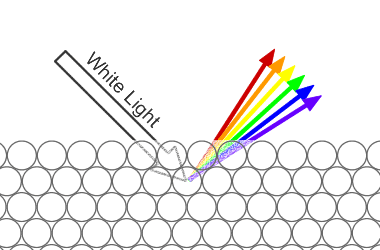
Play-of-Color in Opal: White light enters an opal and interacts with the tiny silica spheres that make up its internal structure. The light is diffracted into its component colors and exits the opal in a flash of spectral colors.
What Causes "Play-of-Color"?
Areas within an opal that produce a play-of-color are made up of millions of microscopic silica spheres arranged in an orderly network. These spheres are only about 1/2 micron in size, and they act as a diffraction grating. As the light passes through, it is diffracted into the colors of the spectrum. The size of the spheres and their geometric packing determine the color and quality of diffracted light.
Sources of Opal
Australia became an important source of precious opal in the late 1800s. Numerous discoveries in the early 1900s gave the country firm leadership of the world's opal production that was not challenged for over a century. Famous mining areas in Australia include: Coober Pedy, Mintabie, Andamooka, Lightning Ridge, Yowah, Koroit, Jundah, Quilpie and others.
Opal production in Mexico also began in the late 1800s. Mexico is best known for its fire opal in bright yellow, orange and red colors.
A series of opal discoveries in the 1990s made Ethiopia an important producer of precious and fire opal. Will growing production in Ethiopia challenge Australia for the world's leadership position?
Other countries that produce precious and fancy varieties of common opal include: Hungary, Indonesia, Brazil, Peru, Honduras, Guatemala, Nicaragua, Slovakia, and Czech Republic. Opal has been produced in several locations in the United States, which include Nevada, Oregon, Idaho, Louisiana, California, Arizona, and Texas. [1]
Wonderful Names Used to Describe Opal
There are many types of opal, and a wide variety of names are used to communicate about them. If you have spent a small amount of time looking at opal, you have probably been surprised by this extensive vocabulary of wonderful names. There is actually a logic behind names such as fire opal, black opal, boulder opal, matrix opal, Coober Pedy, Mintabie, Andamooka, precious opal, opal doublet, and opal triplet. The sections of this webpage below will present that logic and help you see the common sense behind the names. And, since pictures are worth a thousand words, we share our favorite opal photos to help you understand. Enjoy!
Basic Types of Opal: Precious Opal - Common Opal - Fire Opal |
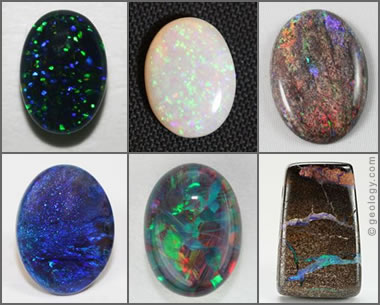
Precious Opal: Several examples of precious opal. Clockwise from top left: pinfire opal, white opal, matrix opal, boulder opal, harlequin opal, black opal.
Precious Opal
"Precious opal" flashes iridescent colors when it is viewed from different angles, when the stone is moved, or when the light source is moved. This phenomenon is known as a "play-of-color." Precious opal can flash a number of colors such as bright yellow, orange, green, blue, red or purple. Play-of-color is what makes opal a popular gem. The desirability of precious opal is based upon color intensity, diversity, uniformity, pattern and ability to be seen from any angle.
Precious opal is very rare and found in a limited number of locations worldwide. Most precious opal to date has been mined in Australia. Ethiopia and Mexico are secondary sources of precious opal. Precious opal is also mined in Brazil, the United States, Canada, Honduras, Indonesia, Zambia, Guatemala, Poland, Peru, and New Zealand. The accompanying image shows several different types of opal that can be called "precious opal."
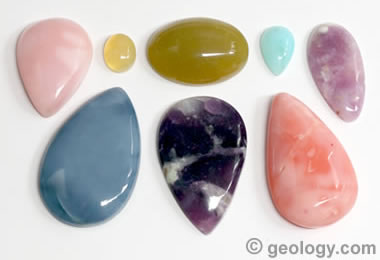
Common Opal: Several examples of common opal that demonstrate the range of high-end color. Clockwise from top left: Peruvian pink, Oregon yellow, Kenyan green, Peruvian blue, Morado from Mexico, Oregon pink, Morado from Mexico, and Oregon blue.
Common Opal
"Common opal" does not exhibit "play-of-color." It is given the name "common" because it is found in many locations throughout the world. Most specimens of common opal are also "common" in appearance and do not attract any commercial attention.
However, some specimens of common opal are attractive and colorful. They can be cut into gemstones of beauty that accept a high polish. They can be attractive and desirable - but they simply lack a play-of-color that would earn them the name "precious." Common opal is frequently cut as a gemstone and can command reasonable prices.
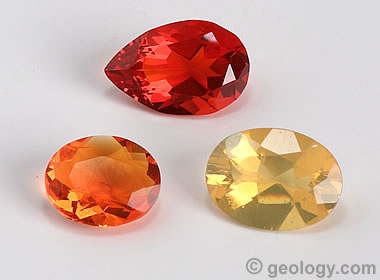
Faceted Fire Opal: Three brilliant examples of faceted fire opal, cut from Mexican rough. These gems have uncommon color for any species of stone.
Fire Opal
"Fire Opal" is a term used for colorful, transparent to translucent opal that has a bright fire-like background color of yellow, orange or red. It may or may not exhibit "play-of-color." The color of fire opal can be as vivid as seen in the three stones shown here.
Some people are confused when they hear the name "fire opal." They immediately expect the "play-of-color" found in precious opal. The word "fire" is simply referring to the red, orange, or yellow background color.
Fire opal might exhibit play-of-color, but such a display is usually weak or absent. Fire opal is simply a specimen of opal with a wonderful fire-like background color. The color is what defines the stone.
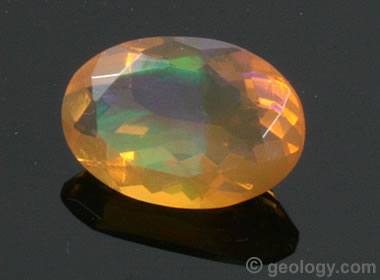
Precious Fire Opal: A faceted orange fire opal with a play-of-color that alternates between green and purple depending upon the direction of observation.
Precious Fire Opal
If you understand the difference between "precious opal" and "fire opal," here is another variation. This opal from Ethiopia has an orange bodycolor, making it a "fire opal," and it also contains an electric green to purple play-of-color, making it a "precious opal." So, we might call this a "precious fire opal." Much of the Ethiopian opal currently being produced has yellow, orange or reddish bodycolor, along with play-of-color, that allows it to be called "precious fire opal."
Opal Names: Based Upon Opal and Host Rock Relationships |
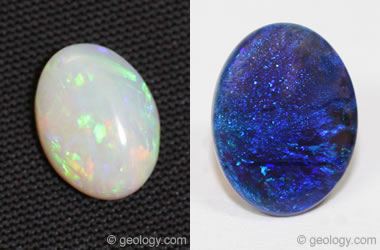
Solid Opal: Two examples of solid opal. On the left is white opal from Coober Pedy, Australia. On the right is black opal from Lightning Ridge, Australia.
Solid Opal --- (Type 1 Opal)
"Solid opal" is a name used for a rough or cut stone that consists entirely of opal material without any host rock or other significant inclusions contained within the stone.
Solid opal can be a combination of precious opal and common opal. Solid opal is also known as "Type 1 Opal." Solid opal is what most people think of when they think of opal.
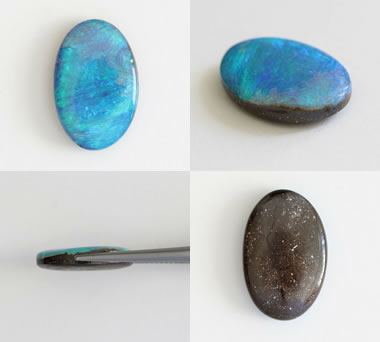
Boulder Opal: The cabochon shown in the four views above was cut from a rock that contained a very thin seam of precious opal. The cutting was skillfully planned to position the thin seam of precious opal as the face of the stone, while preserving a small amount of host rock to serve as a natural backing. The result is a gem that displays full face-up color with a beauty that exceeds or rivals most solid opals. The rough was mined in Winton, Queensland, Australia. It measures 16.89 x 10.98 x 4.19 millimeters. The stone and the photos are by Shinko Sydney.
Boulder Opal --- (Type 2 Opal)
"Boulder opal" is a term used for a rough or cut opal that displays precious opal within its host rock, or precious opal attached to its host rock. Much opal forms within the voids and fractures of its host rock, and specimens of boulder opal can reveal this aspect of opal's origin. Some boulder opal occurs in thin seams and layers that can be cut into a stone that displays only precious opal in the face-up position.
The contrast of color between opal and host rock can be striking. Bright flashes of precious opal are enhanced when seen within dark brown sandstone or with a backing of black basalt. Red fire opal flashing from pink rhyolite is also an impressive sight. Many people enjoy the natural appearance of boulder opal and find these gemstones to be beautiful, interesting, and educational.
In Australia, boulder opal is often called "Type 2 Opal". In Mexico, opal cut within its rhyolite host rock is often called "cantera".
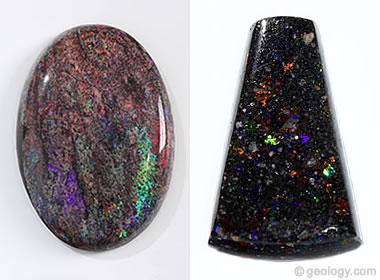
Matrix Opal: The specimen on the left is a cabochon cut from matrix opal mined at Andamooka, Australia. The specimen on the right is a bead cut from matrix opal mined in Honduras.
Matrix Opal --- (Type 3 Opal)
"Matrix opal" is a name used for rough or finished gemstones in which precious opal occurs in intimate mixture with the parent rock. This differs from boulder opal, in which the opal is confined mainly to seams and fractures.
Much matrix opal is found in sedimentary rocks such as sandstone, limestone, chert, or ironstone. In these rocks precious opal has precipitated within the interstitial spaces between sedimentary particles. In some cases it replaces sedimentary material. Andamooka, Australia is the world's most famous locality for matrix opal.
Some matrix opal is found in igneous rocks such as basalt, andesite, or rhyolite. In these rocks the precious opal often occurs as replacements of mineral grains or as infillings of isolated tiny vesicles. Much matrix opal in igneous rocks is found in Honduras, Central America.
Opal Names Determined by Base Color |
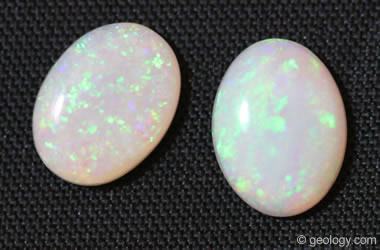
White Opal: Two cabochons of white opal cut from material mined at the famous Coober Pedy, Australia locality. They are calibrated 8 x 6 millimeter cabs.
White Opal or Light Opal
"Light opal" and "white opal" are names used for precious opal with a white, yellow or cream bodycolor. These are the most common bodycolors for precious opal - especially in the early opal that was mined in Australia.
Until the last few decades, white opal was what most people in the United States thought of when they heard the word "opal" - because other varieties of opal were seldom seen in jewelry stores in the United States.
Coober Pedy, South Australia is the most famous locality for producing white opal.
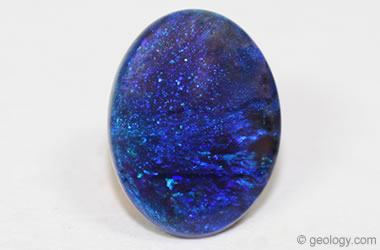
Black Opal: A cabochon of black opal cut from material mined at Lightning Ridge, Australia. It weighs 2.46 carats and measures 9.5 x 12.5 millimeters.
Black Opal or Dark Opal
"Black opal" is a term used for opal that has a dark bodycolor, often black or dark gray. The term is also used for opal that has a dark blue or dark green bodycolor. The dark bodycolor often makes the play-of-color in black opal more obvious.
The contrast of play-of-color to bodycolor makes black opals very desirable and able to be sold for high prices. This specimen is a solid black opal with a strong blue face-up play-of-color. It was mined at Lightning Ridge, Australia, the "Black Opal Capital of the World." It is 2.46 carats in weight and 9.5 x 12.5 millimeters in size.
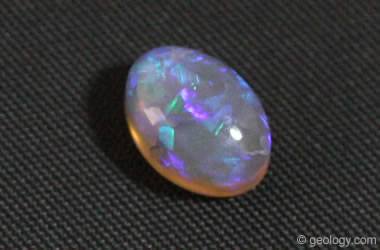
Crystal Opal: A beautiful cabochon of crystal opal with blue and violet play-of-color. It measures 8 x 6 millimeters and was mined at Lightning Ridge, Australia.
Crystal Opal
"Crystal opal" is a name used for transparent to semi-translucent opal that flashes play-of-color surprises from within the stone as it interacts with light.
Crystal opal cabochons make a beautiful collector's stones. Crystal opal is a challenge for a designer because they must produce a setting that allows light to enter and exit the stone in a variety of directions to take full advantage of its colorful display - but dangle earrings are a favorite.
Australia was the first abundant source of crystal opal. In recent years, more is being produced in Ethiopia.
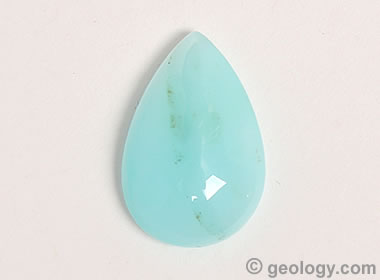
Blue Opal: A beautiful cabochon of blue opal from Peru. It measures 13 x 8 millimeters and weighs 2.3 carats.
Blue Opal
Many people have never seen blue opal and are surprised to learn that such a material exists. It is often cut into beautiful beads and cabochons.
Blue common opal is a highly regarded variety of common opal best known from sources in Peru, Oregon, and Indonesia.
Owyhee blue opal mined in Oregon ranges in color from a light to a dark pastel blue. Blue opal beads from Peru sometimes contain tiny translucent zones with play-of-color. The blue opal found in Indonesia is usually associated with opalized wood.
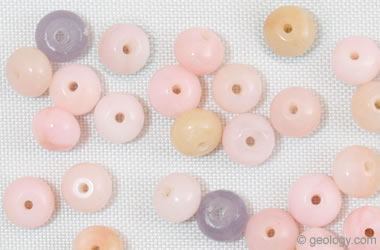
Pink Opal: Beads of pink opal made from material mined in Peru.
Pink Opal
Opal also occurs in shades of pink. These pink opal beads were made from common opal mined in Peru. They are about four millimeters across and range in color from nearly white, through carnation pink, through lilac.
Peru is the best-known source of common opal with a pink color. Small amounts of pink opal are found in Oregon. Some people call the rhyolite-hosted fire opal of Mexico a "pink opal".
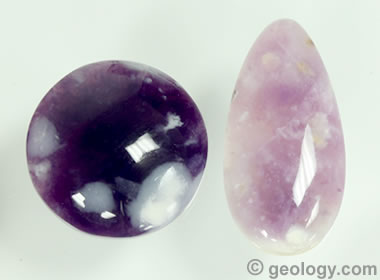
Morado: Two cabochons of Morado opal from Mexico. A 19 millimeter round and a 13 x 26 millimeter teardrop.
Morado Opal
"Morado" is the Spanish word for "purple." Some common opal with a purple bodycolor is produced in Mexico. It is widely known as "Morado Opal" or simply as "Morado". In the world there are very few sources of opal with a rich purple color.
Names That Describe an Opal's Color Pattern |
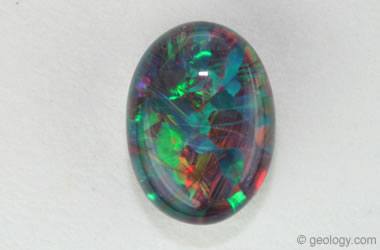
Harlequin Opal: A beautiful harlequin opal from the Constellation Mine in Spencer Idaho. It is 6 x 4 millimeters.
Harlequin Opal
"Harlequin opal" is a name given to an opal that displays patches of color in the shape of rectangles or diamonds.
The "Harlequin" color pattern is normally exhibited in two dimensions on the face of the stone. However, less often the color patches can be seen within a transparent stone - in a three-dimensional display. This is what you will see in the stone in the accompanying image.
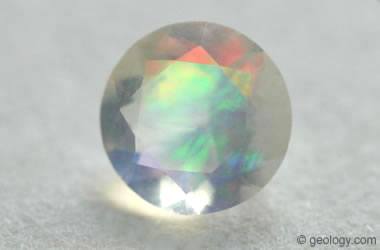
Contra-Luz Opal displays its play-of-color when illuminated by a light source on the back side of the stone. An example is holding the opal up to a sunny sky and observing it from an angle that allows sunlight to pass through the stone and into the eye of the observer. Photo by Sandy Craig of Orca Gems.
Contra-Luz Opal
"Contra-Luz" is an intriguing variety of opal that best displays play-of-color when the light source is behind the stone and the light travels through the stone and into the eye of the observer.
Because the contra-luz effect only occurs when light travels through the stone, a contra-luz opal must be transparent or semi-transparent.
Utilizing contra-luz opal in jewelry requires a setting that allows light to pass through the stone. An example would be a pair of earrings made using beads of highly transparent contra-luz opal that dangle below the ear lobes. Light passing through the beads will produce a display of color when the observer, the light source, and a bead are in alignment.
Pinfire Opal (also Pinpoint Opal)
"Pinfire opal" is a name used for opal that has pinpoints of color throughout the stone. The opal on the left is a pinfire opal cut from material mined at Coober Pedy, Australia. The stone on the right is a pinfire opal from the Constellation Mine in Spencer, Idaho. It is 6 millimeters by 4 millimeters in size.
Cat's-Eye Opal
Rarely, opal will display chatoyancy, the optical effect that produces a "cat's-eye" across the surface of a stone. In these opals, a thin line of bright light is reflected from a parallel network of needle-shaped inclusions within the gem.
The line, or the "eye", tracks back and forth across the dome of the stone as the stone is moved, as the light source is moved, or as the head of the observer is moved. Shown here is a cat's-eye opal from Madagascar. Its chatoyancy is produced by hundreds of parallel rutile needles that span the width of the stone and reflect a line of light much like the line of light that is reflected from the surface of a spool of silk thread.
Opal Names Determined by Geography |
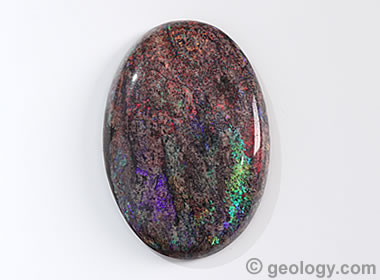
Andamooka Opal
Andamooka is one of the early mining districts of South Australia. Commercial production began there in the 1920s. The area is famous for its matrix opal - with the play of color distributed through a matrix of limestone, sandstone or quartzite. The stone in the photo is a cabochon cut from Andamooka matrix and weighs about 30 carats.
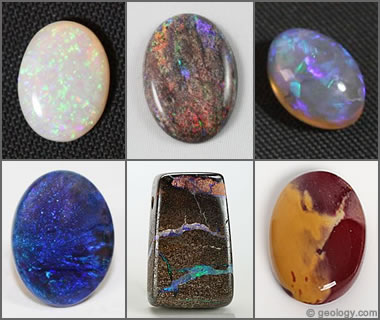
Australian Opal
Australia has been the world's leading source of opal for over 150 years. It has produced ten times more opal than the rest of the world combined. Numerous world-famous localities in the country produce distinct varieties of opal. Precious, black, matrix, water, boulder, jelly, common, and other types of opal are all found in Australia.
Shown in the photo, clockwise from top left: Precious white pinfire opal from Coober Pedy; matrix opal from Andamooka; crystal opal from Lightning Ridge; mookaite common opal from Western Australia; boulder opal from an unknown locality; black opal from Lightning Ridge.
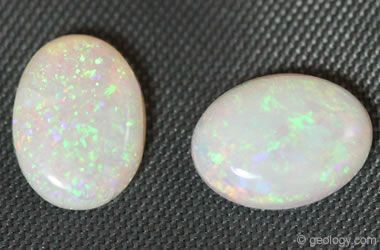
Coober Pedy Opal
Coober Pedy is a small town in South Australia that was first settled in 1916 when mining for opals began. It was one of the early prolific producing areas and has earned the nickname of "Opal Capital of the World." Coober Pedy is famous for producing white base-color opals, and production has continued uninterrupted since 1916. The stones pictured are white Coober Pedy opals cut to a calibrated size of 8 x 6 millimeters.
Ethiopian Opal
Gem-quality opal from Ethiopia began entering the market in significant amounts starting in 1994. Since then, additional opal deposits have been discovered that might be large enough in size to take significant market share away from Australia, which has supplied nearly 100% of the opal market for over 100 years. Precious opal, fire opal, and very attractive common opal are all being produced in Ethiopia. They are becoming more abundant in the gem and jewelry market and more popular with consumers.

Honduras Black Opal
Honduras is well known for producing a black, basalt-matrix opal that contains tiny vesicles filled with play-of-color opal. Most people who know opal will understand exactly what you are talking about if you use the term "Honduras Black Opal." The specimen shown is a cabochon cut from Honduras Black Opal. Cabochon and photo by Stony Mountain Studio.
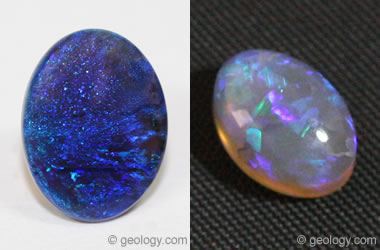
Lightning Ridge Opal
Lightning Ridge is a town in New South Wales, Australia that has become world-famous for its deposits of black opal. More black opals have been produced at Lightning Ridge than at any other location in the world. The specimen on the left is a solid black opal with a strong blue face-up color mined at Lightning Ridge. It is 2.46 carats in weight and 9.5 x 12.5 millimeters in size. The specimen on the right is a solid crystal opal with blue to lavender play-of-color cut as an 8 x 6 cabochon.
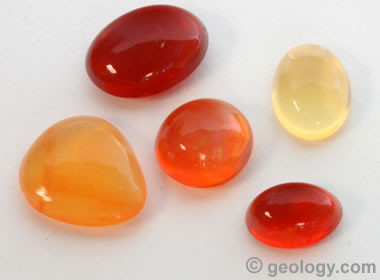
Mexican Opal
Mexico is famous for being the world's most important source of fire opal. Mexican fire opal is known for having the most saturated and purest hues. Mexican fire opal is cut into beautiful cabochons, and much is cut into brightly-colored faceted stones. Mexico also produces beautiful precious opal. A unique cutting style, known as cantera, yields cabochons that display pockets of fire opal in their rhyolite matrix. The cabochons shown here were cut from fire opal found in Mexico. They all have a bright red, orange or yellow background color.
Louisiana Opal
"Louisiana opal" is a quartzite cemented with precious opal that has been mined in Vernon Parish, Louisiana. On close examination you can clearly see quartz grains with the spaces between them filled with a matrix of clear cement that produces a play-of-color in incident light. It is a stable material that can be cut into cabochons, spheres and other objects. Some of the material is brown like the 20mm x 20mm cabochon pictured, but it also occurs in a gray to black color that makes the play-of-color easier to see.
Peruvian Opal
Peru produces some of the world's most beautiful opal. It is not play-of-color opal; instead, it is common opal of uncommon color. Opal mines in Peru yield common opal in pastel colors of blue, green, and pink. The accompanying photo shows strands of rondelle-shaped beads in all three colors. Play-of-color is not needed to have beauty in common opal. The beads in the photo are about seven millimeters in diameter. Peruvian opal is also used to make beautiful cabochons and tumbled stones.
Names Used for Assembled Stones |
Assembled or Composite Stones
Most cut opals are solid stones. The entire stone is cut from a single piece of rough (see top illustration).
However, some opal rough has very thin but brilliant layers of play-of-color material. Some artisans cut the stone down to the thin color layer and glue it to a base of obsidian, potch, basalt, or plastic - then cut a finished stone. These two-part stones are called "opal doublets" (see center illustration).
To protect the fragile opal from abrasion and impact, some artisans glue a transparent cap of quartz, spinel or other transparent material onto the opal. This produces a three-part stone, called an "opal triplet" (see in the bottom illustration).
Opal Doublet
The two pictures shown here are of the same stone. The picture on the left shows the face-up appearance of the stone. The picture on the right is a side view. This stone is an opal doublet that was assembled from a thin layer of precious opal glued to a backing of host rock. In the side view you can clearly see the "glue line" between the two materials. If this stone was mounted in a setting with a cup bezel, it might be impossible to tell if it was a solid opal or a doublet.
Opal Triplet
The two stones pictured are opal triplets produced by sandwiching a thin layer of precious opal between a backing of black obsidian and a cover made of clear synthetic spinel. The clear top acts like a magnifying lens and enhances the appearance of the thin precious layer. The black obsidian back provides a contrasting background that makes the play-of-color in the precious layer more obvious. If you look very closely at the inverted stone, you will see a tiny line of color that is the edge of a thin slice of precious opal.
Names Used for Opal and Opal Look-Alikes |

Natural Opal
Because of opal's beauty and desirability, people have been producing materials that look like opal for nearly a century. A person with a little experience can easily recognize most of the "look-alikes." "Natural opal" is the name used for genuine opal that has been mined from the Earth. It is genuine opal made by nature and not by humans. The specimen here is a black opal mined at Lightning Ridge, Australia.
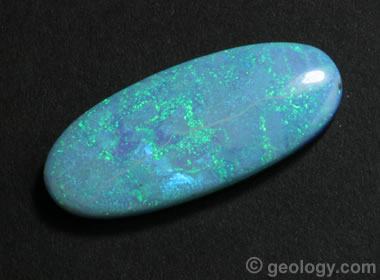
Synthetic Opal: A beautiful cabochon of synthetic opal with a beautiful blue and green play-of-color. This cabochon measures about 27 x 12 millimeters and was produced by Sterling Opal.
Synthetic Opal
"Synthetic opal", "lab-created opal", "lab-grown opal", and "man-made opal" are some of the names used for opal which has been made by humans. These opals are made from materials that have the same chemical composition as natural opal. They also have the same physical properties and appearance of natural opal. These man-made opals can have spectacular play-of-color and beauty that rivals some of the best natural opals, and they usually sell for a much lower price.
Synthetic opal has been made since the 1970s. An untrained person might not realize that an opal is synthetic, but trained gemologists can usually tell synthetic opal from natural opal by examination with a loupe or microscope. However, some synthetic opals are so convincing that trained gemologists must send suspect specimens to a laboratory for positive identification.
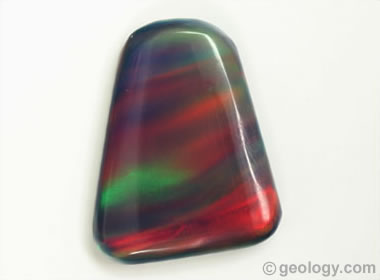
Imitation Opal: A beautiful example of imitation opal with a swirly play-of-color. It is composed mostly of resin. We submitted this stone to the Gemological Institute of America Laboratory to confirm that it was imitation opal and not synthetic opal. It was sold to us as an "Aurora Opal". You can see the report here.
Imitation Opal
"Imitation opals" are natural or man-made materials that have an appearance that is similar to natural opal. Man-made imitation opals are usually made of glass, resin or plastic. They are not natural opals and must be sold with a disclosure that clearly communicates to the buyer that the item is an "imitation opal" or an "opal-like product" or an "opal imitation". Imitation opals are used as a low-cost substitute for natural opals. They can be as beautiful as natural opals and can sometimes fool an experienced gemologist if they are well made.
Imitation opals have been made since the 1960s. They are becoming more common in the gem and jewelry market, and their appearance is becoming harder to distinguish from natural opal. Many people enjoy their appearance and appreciate their lower cost. They sometimes are sold under trade names that include "Opalite" or "Opal Essence" or "Aurora Opals". Imitation opals are beautiful and legitimate products if they are sold with clear disclosure.
Other Opals |
Opalized Wood
Opalized wood is a type of petrified wood that is composed of opal rather than chalcedony or another mineral material. It almost always consists of common opal, without play-of-color, but rare instances of petrified wood composed of precious opal are known. Petrified wood composed of opal is often thought to be composed of chalcedony because many people do not know that petrified wood can be opaline. These two types of silicified wood can be easily separated by testing their hardness, specific gravity, or refractive index.
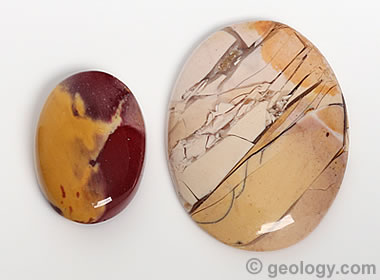
Mookaite Opal
"Mookaite" is the trade name for an opaque gem material with spectacular color patterns that is mined in Western Australia. Gemological testing identifies most mookaite as a chalcedony. However, some mookaite has the refractive index and specific gravity of opal. The cabochon on the left has the familiar color pattern of mookaite. The cabochon on the right has the less-familiar brecciated appearance. Both can be properly called "common opal". Here's the GIA lab report for the stone on the left.
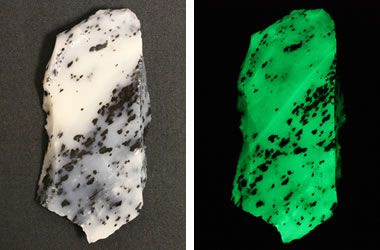
Fluorescent Opal
Most opal will glow or fluoresce weakly under an ultraviolet lamp. However, some specimens exhibit a spectacular fluorescence. This specimen of mossy common opal rough from Virgin Valley, Nevada fluoresces a brilliant green under UV light. The photo on the left was taken under normal light, and the photo on the right was taken under a short-wave ultraviolet lamp.
Opalite
The name "opalite" has been used in two ways. Its original use was for common opal without play-of-color. That definition of opalite has been published in geology and gemology glossaries for decades. In the 1980s, the name "opalite" started to be used as a marketing term for a plastic imitation opal with true play-of-color. That use has since spread to a variety of plastic and glass materials that look like opal or have an opalescent appearance.
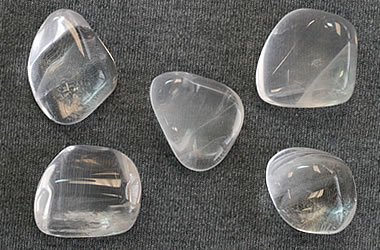
"Water Opal" or Hyalite
Some opal does not exhibit a "play-of-color," does not have a base color, and does not have a bodycolor like most common opals. But this material is still opal. The tumbled opals pictured are examples of this material. It has been called "water opal" and "hyalite."
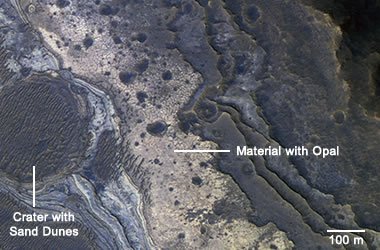
Opals on Mars?
In 2008, NASA's Mars Reconnaissance Orbiter discovered a number of opal deposits on Mars. In this satellite image, the surface in the pinkish cream-colored area to the right of the impact crater is covered with hydrated silica rock debris that we would call "opal." Mars researchers have also identified layers of opal exposed in the outcrops of crater walls. Since opal is a hydrated silicate its formation requires water. So, the discovery of opal on Mars is another evidence that water once existed on the planet. Image by NASA.
| More Gemstones |
 |
Birthstones |
 |
Gifts That Rock |
 |
Diamond |
 |
Polka Dot Agate |
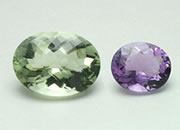 |
Prasiolite |
 |
Bloodstone |
 |
Blue Gemstones |
 |
Tourmaline |

Find Other Topics on Geology.com:

|

| ||

|

| ||

|

| ||

|

|

